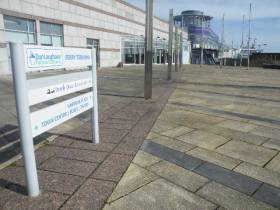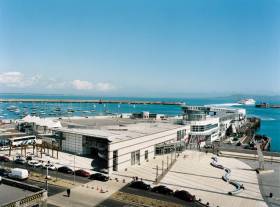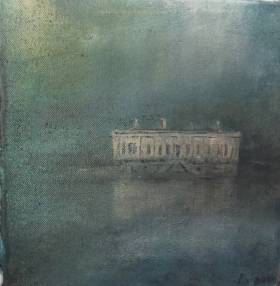Displaying items by tag: Ferry Terminal
Deadline of June 2023 for New Isle of Man Ferry Terminal in Liverpool 'Still Realistic'
The Isle of Man Minister for Infrastructure doesn't think the ferry terminal project will cost more than already requested.
The minister doesn't believe work to the Liverpool Ferry Terminal project will cost more than has already been requested by his predecessor.
The project is expected to cost more than double what was initially requested of Tynwald.
Chris Thomas insists the June 2023 deadline is still realistic and says whilst not everything was straight forward with this project - he believes it's not right to penalise other off-Island projects in future.
ManxRadio reports including a link to the podcast with the Minister spreaking on the terminal that is to serve the route to Douglas Harbour.
#dublinbay - The Irish Times writes that Dún Laoghaire-Rathdown County Council has rejected a proposal from $5 billion US children’s entertainment giant Hasbro to bring “Hollywood production” to the Dublin suburb with a studio in the harbour's former Stena Line terminal.
The US company submitted a joint expression of interest for the vacant building, which has lain unused since 2015, along with Irish animation studio Boulder Media, which it purchased in 2016.
According to the tender document submitted by the pair, the project would see “a truly unique studio and academic facility with stand-out identity and world-wide appeal. Hollywood production would truly be happening in the centre of Dún Laoghaire – with regularity”.
The tender, which has been seen by The Irish Times, states that the studio would house 350-400 crew and management “from day 1, rising to 650”. It continues: “Local spend of our highly skilled, higher earning creative and media professionals would also be very considerable.”
Hasbro is planning to use Boulder Media for a number of theatrical released movies on a long-term repeating cycle, which would support a €5 million investment in bringing the existing building up to standard.
More on the story can be read here through this link.
Expressions of Interest Sought by Council for Dún Laoghaire Ferry Terminal
#dublinbay - New expressions of interest will be sought by Dún Laoghaire-Rathdown County Council for the former Stena Line ferry terminal site after a €20 million plan to convert it into a technology hub stalled late last year.
“Dún Laoghaire-Rathdown will be seeking expressions of interest for the development of the ferry terminal building in the next few weeks. Information sought will include production of a robust business plan and adequate proof of funding for the first three years of the project,” a spokeswoman for the local authority told The Irish Times.
The council is seeking expressions from consortiums, businesses, commercial interests, entrepreneurs or other individuals who will “develop and manage the property and offer space to the business sector while providing a positive economic impact for Dún Laoghaire town”.
Estate agent Lisney has been appointed to find an occupier. The building has a 10-year planning permission with an option to extend for a further period of five years.
Investor Philip Gannon had been leading a plan to transform the empty terminal into a 7,000 square metre digital hub, but last October pulled out of the project. Mr Gannon terminated his lease on the site after issues emerged over the lack of a foreshore licence needed to develop the property correctly.
The technology investor Ian Lucey had also been involved in the project to develop the terminal, but relations between him and Mr Gannon broke down some time ago. Mr Lucey has expressed an interest in continuing to be involved in the development if possible.
For much more on The Irish Times story, click here.
Ferry Terminal in Dún Laoghaire May Become Tech-Centre
#FerryTerminal - A change of use through a planning application of the former ferry terminal in Dún Laoghaire Harbour, from duty-free shops and passenger services to a 450-job technology cluster, is to be lodged in coming weeks.
The move writes The Irish Times comes as Dún Laoghaire Harbour Company is in advanced negotiations with a preferred bidder for a multimillion euro, 10-year lease on the building.
The plan to redesignate the terminal is an attempt to generate an income from the building, which was opened 22 years ago to facilitate Stena’s Dún Laoghaire-Holyhead ferry service, which was subsequently withdrawn
The Harbour Company is also selling a small parcel of land known as “the gut” at the base of the west pier. Both moves are designed to generate income to meet the harbour company’s core objective of maintaining the harbour itself. Last year the Harbour Company spent €1 million on repairs to the Carlisle Pier and further repairs are needed to the west pier.
Confirming the negotiations on the lease and change of use of the former ferry terminal at St Michael’s Pier, Gerry Dunne, chief executive of the harbour company, said a public tender process had identified a preferred bidder for a 10-year lease on the building.
The newspaper has more on the story, click here.
#HarbourArt - At the end of this month the Dun Laoghaire Harbour Company are to mark the 200th anniversary of the laying of the first stone of the Harbour in 1817.
This is to take place on Wednesday 31st May when President D Higgins will officially open a busy 6 months programme of art, drama, food and historical events about the harbour town that in 1821 was renamed Kingstown. This was to honour the visit of King George VI during the harbour's construction.
Contemporary Harbour Art Exhibition
Launching today, Tuesday 16th May the Gallery Dalkey presents an exhibition (in Dun Laoghaire at the Ferry Terminal building). The exhibition is been held in conjunction with the Dun Laoghaire Harbour Bicentenary Group to commemorate the historic year.
Peter Pearson, a local historian, author and artist involved in the Bicentenary celebrations will feature pieces from his collection since the 1970’s. The Maritime aspect of Dun Laoghaire, its Harbour seafront, sailing boats, yachts and car ferries remain a lifelong influence for Peter.
Other artists showing will be Yvonne Moore, Mary O Connor, Keith Dixon, Sonya Kinch, Rod Coyne, Brigitte McGovern, Leonard Sexton, John Short, Maureen Boalch, Tania Tsaryk, Denise French & Jacqueline Holohan.
Speaking about the summer of events ahead, CEO of the Dun Laoghaire Harbour Company, Gerry Dunne, said: “This Contemporary Art Exhibition is one of over 25 free events taking place to commemorate our Bicentenary year.
We welcome members of the public to get involved and find out more by logging on to dlharbour200.ie”
The Exhibition will continue at the Ferry Terminal, St. Micheals Pier until Sunday 5th June. Opening times: 11:00 – 17:30 (Closed Mondays)
Entry is free and open to the public. Paintings are available for sale.
HSS Fast-Craft to Return on Dun Laoghaire Route
According to Stena Line over 70% of its passengers business is carried by the HSS Stena Explorer in the high season. It is felt that the 1996 Finnish built fast-craft is better suited for the service due to a loyal customer base which was reflected by repeat bookings and their preference of the HSS craft on the 120 minute (2 hour) route.
A daily single round trip is scheduled with sailings from Dun Laoghaire to Holyhead departing at 13:15hrs. The corresponding sailing from the Anglesey port departs at 10.00hrs and arrives at the Irish port at 12 noon. Sailings will operate through the summer until 13 September.
From there on Stena will make a decision as to its continuing schedule, though it is widely believed that the prospects of the fuel-thirsty, expensive to run HSS fast-craft service are likely to be at an end of an era.
Last month negotiations over the core issue of harbour fees were held between Stena Line and Dun Laoghaire Harbour Company. It is understood that the annual fee of €6.5m was dropped to €2m. The board of the harbour company has given a 'conditional green light' of a new ferry contract to Stena Line to run the service for the next two years with an option of a third year.
The service closed for its seasonal break earlier this year on 5 January with the 'Lynx' going into temporary lay-up at Holyhead's inner harbour to join the HSS Stena Explorer. The HSS had been 'wintering' at the port since September sailings were taken over by the Lynx.
Earlier this month the Stena Lynx III came to Dun Laoghaire to continue her lay-up period. The 1996 Tasmanian built craft will stay there before resuming seasonal sailings between Rosslare-Fishguard in tandem with the conventional ferry Stena Europe.
In the meantime the craft is berthed at the harbour's two-berth ferry terminal at St. Michaels Wharf. The HSS berth is only designed for this type of fast-craft whereas the other berth now occupied by the Lynx was built originally for conventional ferries but was re-configured last year to suit the fast-craft.


































































